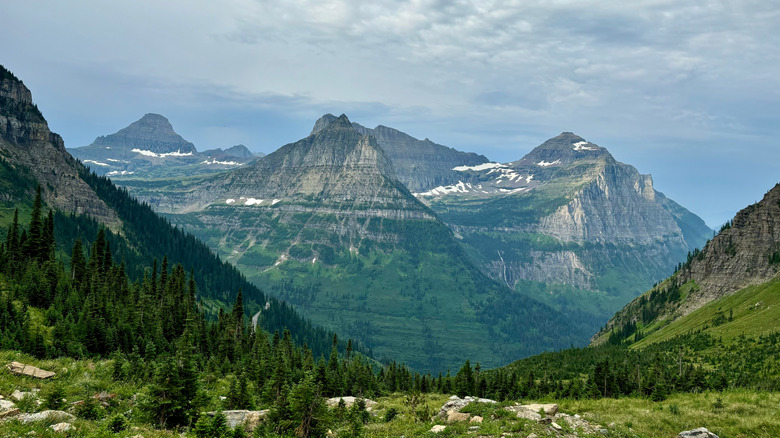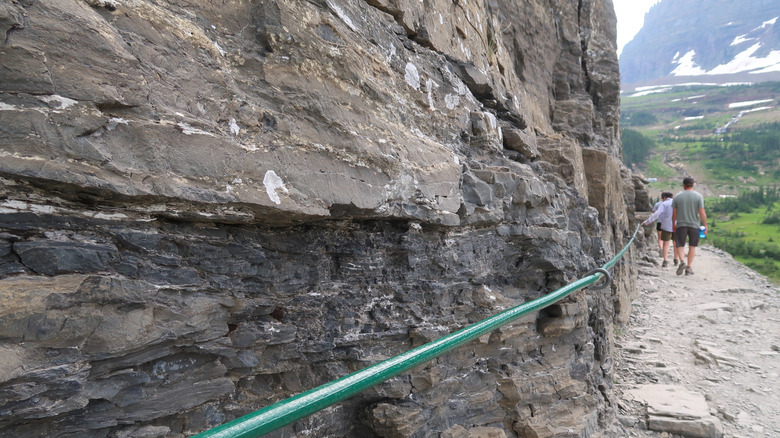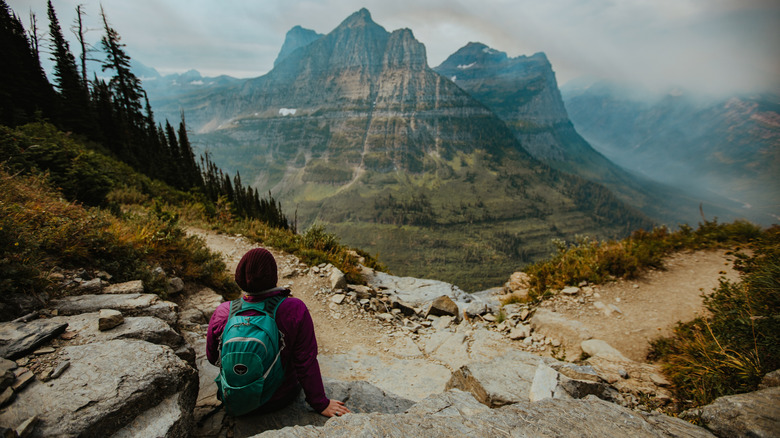Glacier National Park's Most Strenuous, Adrenaline-Pumping Trail Is Arguably Its Prettiest
A visit to Montana's Glacier National Park is one you won't forget. Often referred to as the Crown of the Continent for its unmatched beauty, it's one of the best national parks in North America. Highline Trail is arguably the most thrilling way to experience Glacier's rugged beauty, as the strenuous path winds 12 miles into the wilderness while climbing around 2,000 feet — providing unparalleled views of the Rocky Mountains. Highline Trail isn't a hike you decide to take on a whim, however, as it requires careful planning and extreme confidence to safely navigate some of its most treacherous sections.
Featuring sheer cliffs and steep drops, many sections of the Highline Trail require nerves of steel. One portion even features a permanent hand cable that's been installed by the National Park Service, helping travelers steady themselves while walking inches away from a vertical dropoff. It's a hike that's bound to get your adrenaline pumping, but as long as you come prepared and know what to expect, Highline Trail is worth the effort. Beyond dramatic views into the valley below, you'll get the chance to see a variety of wildlife, patches of colorful wildflowers, and even make a pit stop at the scenic Granite Park Chalet, a National Historic Landmark. It's a truly spectacular adventure, and if you don't mind a serious workout, it'll likely become the highlight of your time in Glacier National Park.
Hiking the Highline Trail in Glacier National Park
Before you even set foot on the trail, you'll be treated to awe-inspiring views as you drive through one of America's most scenic roads. Going-to-the-Sun Road takes you to Logan Pass — and it's here you'll find the start of your journey. This is also where you'll find the Logan Pass Visitor Center and its large parking lot, which serves as an excellent place to get your gear together before venturing out.
Highline Trail can be tackled in several ways, but the most common methods are as an out-and-back or as a loop. If you're going out and back, you can simply hike Highline Trail until you get to Granite Park Chalet, then retrace your steps back to Logan Pass. This route doesn't require a shuttle bus, but it does mean you'll navigate the steep Highline Trail both uphill and downhill — which can be hard on your knees.
Many find the better option is looping Highline Trail together with Granite Park Trail. Doing this will end your hike at the Loop Trailhead, offering a shuttle stop that'll bring you right back to Logan Pass, where you started. If you're interested in this, be sure to keep a close eye on the time so you don't miss out on the last shuttle. Regardless of which route you take, be sure to hike the Garden Wall Trail. This offshoot soars an additional 900 feet into the sky, bringing you to the top of the Continental Divide.
Gearing up for Highline Trail
Since most variations of the Highline Trail require you to hike over 12 miles and climb over 1,500 feet of elevation, it's important to prepare for a challenge. First and foremost, travelers from lower elevations should spend time acclimating to the altitude. You'll reach elevations over 7,000 feet during your journey, and if you're coming from sea level, you'll likely experience altitude sickness. To combat this, explore smaller hikes in the area to prepare your body — such as Hidden Lake Overlook, which also begins at Logan Pass but runs for just 2.7 miles.
Deciding when to start the hike is another critical consideration. The parking lot at Logan Pass Visitor Center can fill up fast, so be sure to arrive very early in the morning. You can then set out as soon as you arrive to avoid getting caught in the hot sun, as the trail offers little shade. Conversely, starting later means more of the landscape will be illuminated instead of hidden in shadows. Can't find a parking spot? Check out another hike that takes you to Glacier National Park's largest lake.
As for gear, you'll want to pack lots of water, snacks, a medical kit, and a great pair of hiking shoes. It's also not a bad idea to bring a rain jacket and wear layers of clothing. Bear spray is a wise option, as the park is home to over 1,000 of them — including both black bears and grizzly bears.


